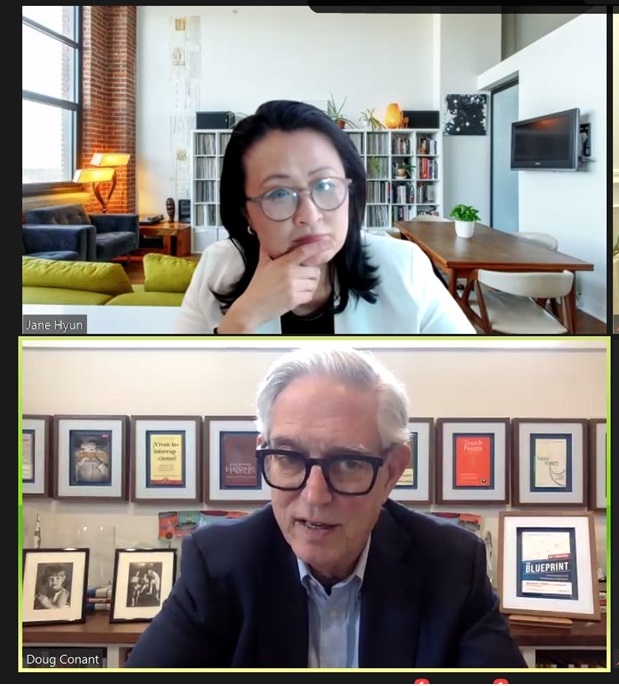‘Stretch Your Cultural Comfort Zone’—Jane Hyun & Doug Conant on Cultural Fluency in Leadership
At ConantLeadership’s recent BLUEPRINT Leadership Summit—a biannual, virtual meeting of the top minds in leadership—Jane Hyun (the premiere global expert in cultural fluency and celebrated author of Breaking the Bamboo Ceiling, FLEX, and her new book, Leadership Toolkit for Asians) spoke with Doug Conant (Founder of ConantLeadership, former CEO of Campbell Soup Company, and bestselling author of The Blueprint and TouchPoints). Together, they talked about how to embrace cross-cultural effectiveness, understand cultural fluency, and authentically lead a multicultural workforce.
 Enjoy the following tips and takeaways from their conversation in the recap below. You can also watch the recording of their discussion (skip to roughly minute 5 to skip intros and housekeeping).
Enjoy the following tips and takeaways from their conversation in the recap below. You can also watch the recording of their discussion (skip to roughly minute 5 to skip intros and housekeeping).
Not Everyone Looks Through the Same Lens
Jane Hyun, a global leadership strategist and trusted coach to multinational companies, wasn’t always the expert in cross-cultural effectiveness that we know today. Her unique life experiences shaped the cultural awareness and agility she now exudes and champions.
One formative experience occurred shortly after Hyun moved from South Korea to the United States as a child. She had what she describes as a “disorienting moment” when witnessing a classmate voice his disagreement with the teacher. She recalls being surprised when the teacher not only responded with kindness, but with affirmation that everyone should “have their own thought” about what was being taught in the classroom. This open-armed embrace of differing opinions was jarring at the time. Given Hyun’s cultural background, she had viewed her classmate’s interjection as disrespectful and perhaps even punishable.
Hyun had many subsequent moments of culture shock as she learned to adapt across different life stages in the U.S. When she eventually entered Wall Street as an adult, she again had to navigate a difficult cultural shift—working in a male-dominated space: “As an outsider trying to figure out the unwritten rules,” she realized that being able to work, communicate, and thrive in a cross-cultural environment was a widely underdeveloped skill, ripe territory for exploration. And as her career progressed into the coaching space it became clearer: Cultural fluency “is something that we can teach, right? This is something we can help people develop.”
Fast forward to today and Hyun is a skilled “interpreter” for leaders who want to effectively manage people across differences. Trusted among the Fortune 500, she defines cultural fluency as “engaging, working, and communicating effectively with people who are different from you,” and the skill extends to “looking at the visible differences as well as the invisible differences,” and being able to navigate those too.
Building cultural fluency is a skill that Doug Conant, a champion of inclusion and people-first leadership, classifies as “arguably the most important trend in organization development.” He acknowledges that today’s global, matrixed organizational landscape is marked by cultural differences that expand beyond ethnicity to include gender, generation, geography, and so much more: “Not everybody is looking through the same lens you are.” An excellent reminder for us all.
“Take a risk and get to know at least one person outside of your immediate cultural community.”
Start with Curiosity and Kindness—Then Don’t Forget to Take Action
In business and in life, the stakes are too high to gloss over cultural differences. It’s not that any singular group must ‘go along to get along.’ Instead, leaders need to actively work through cultural variations in a way that, according to Conant, aims to “respect the people in the room.” Without respect and cross-cultural affirmation, leaders are much less likely to drive high-performance results and build functioning teams.
Hyun has witnessed firsthand the chaos that abounds when cultural fluency isn’t prioritized. For example, she once worked with a consumer products company with locations scattered across the globe: Research and development in Asia, manufacturing in Germany, sales and marketing in North America. Projects shifted from one region to the next with no regard for the cultural differences at play, and as a result, miscommunication and missed deadlines became the norm. She recalls: “There was chaos, there were delays, and there was a lot of upset people who wanted to know what was going on.”
For leaders in similar situations, things will only begin to change when they acknowledge cultural differences with curiosity, kindness, and an inclusive action plan to move forward. Otherwise, Hyun points out the grim alternative: “If we don’t understand the impact of culture in business, in society, in our schools . . . we’re going to have problems that stay unresolved.” And the resulting chaos will spread exponentially.
Still, bridging cultural gaps and effectively leading a multicultural workforce can feel daunting if leaders aren’t sure where or how to start. Conant asks Hyun two pertinent questions to help leaders take initiative:
- How would one discover or diagnose how culturally fluent they are?
- And what are the key barriers to building cultural fluency in leadership?
Hyun recommends an objective assessment of the situation as the first imperative in a three-pronged approach of:
- Observation
- Inquiry
- Feedback and iteration
She says an external analysis is a crucial initial step because when you’re leading people who are culturally different from you, “you may not always be able to rely on your own assessment of the situation.” It’s best to engage another party—whether it’s an outside coach, a manager within the company, someone who has experience with that particular cultural group, or an assessment like the Intercultural Development Inventory (IDI), which provides a “snapshot of how you navigate and think about difference.”
This is where Hyun shines. Her new book, Leadership Toolkit for Asians, is filled with self-assessments, checklists, quizzes, and inspiring stories of culturally relevant leadership. While it’s written specifically to help Asian leaders be influential in a way that feels culturally authentic, leaders from any background can gain insight from Hyun’s important work—including her first book, Breaking the Bamboo Ceiling, which Conant regards as “seminal” and beneficial to anyone who is learning to operate “in a dominant culture that’s unfamiliar.”
Hyun also cautions leaders not to get stuck in the reflection stage. Acknowledgement of differences is a good first step, but can actually be a barrier to cultural fluency if leaders stop there: “If you just overthink things and stay curious, but you never act and take yourselves out of your cultural comfort zone, then you’re not building that cultural fluency at all.”
Conant agrees and urges leaders not to get too overwhelmed by the complexity of it all. Quoting from Jim Collins’ book, Good to Great, he adds that leaders must “confront the brutal facts” and then focus on “navigating through the feedback in order to be productive.” Push past the inclination to merely fix issues in the short term or autopilot through cultural differences. Instead, ask questions, invite open conversation, and cultivate psychological safety for the people you lead. Otherwise, Conant says, “you’ll never get the candor you need to really get at what the issues are.”
“You will learn things that you never would have learned from far away.”
Be Adaptive and Authentic at the Same Time
Hyun says that leaders at any stage in their career must learn how to be “adaptive and authentic at the same time.” In practice, this could look like reevaluating which corporate jargon or acronyms are used and understanding whether they make sense in the context of different cultures or even different departments. It could also look like setting up conflict resolution protocols before working on cross-functional, multicultural teams.
Misunderstandings due to language barriers are another issue that Hyun says can be “a complete blind spot.” She illustrates this with the Korean language, which uses honorific speech in some cases, and informal speech in others, to show respect and maintain a social hierarchy. Simply telling a person in this culture to use informal language isn’t going to work because, “we need to be aware that language is not only in the words themselves, but how it’s spoken and how they address you,” she clarifies. Be cognizant of power dynamics in languages because, “it could be the difference between respect and disrespect.”
Hyun encourages everyone, regardless of background, to “take a risk and get to know at least one person outside of your immediate cultural community” because “you will learn things that you never would have learned from far away.” Conant, a longtime proponent of humility in leadership, advocates for “studying the world around you through the eyes of someone else that you would like to get to know better” and adds that it’s enjoyable to follow Hyun’s teachings because you get to celebrate a “rainbow of rich, interesting people.”
Hyun offers these inspirational parting words for those who want to take the humble, purposeful path toward cultural fluency: “It only takes one step at a time. You don’t have to do a million things. You just have to figure out one thing you can do differently to stretch your cultural comfort zone.”
__
Enjoyed These Insights?
Jane Hyun’s new book, Leadership Toolkit for Asians, is available wherever books are sold. Also, continue your learning with the article co-authored by Doug Conant and Jane Hyun in Harvard Business Review, “3 Ways to Improve Your Cultural Fluency.” Then, watch the full recording of this interview to get more details, including insights from an audience Q&A. You can also access the complete inventory of previous BLUEPRINT Leadership Summit sessions, including illuminating conversations with Brené Brown, Susan Cain, Indra Nooyi, Amy Edmondson, Bill George, Barbara Humpton, and many more.
 About the author: Vanessa Bradford is a freelance content writer and copywriter, and C3PR’s Content Marketing Director.
About the author: Vanessa Bradford is a freelance content writer and copywriter, and C3PR’s Content Marketing Director.
(Cover photo by Louis Hansel on Unsplash)

“Doug Conant is remarkable—and so is this work.“
– Stephen M. R. Covey
Author of The Speed of Trust

The Blueprint
6 Practical Steps to Lift Your Leadership to New Heights
By Douglas Conant with Amy Federman

Have Doug Speak at Your Event
Doug works collaboratively with event organizers to customize his material for each audience.




0 Comments